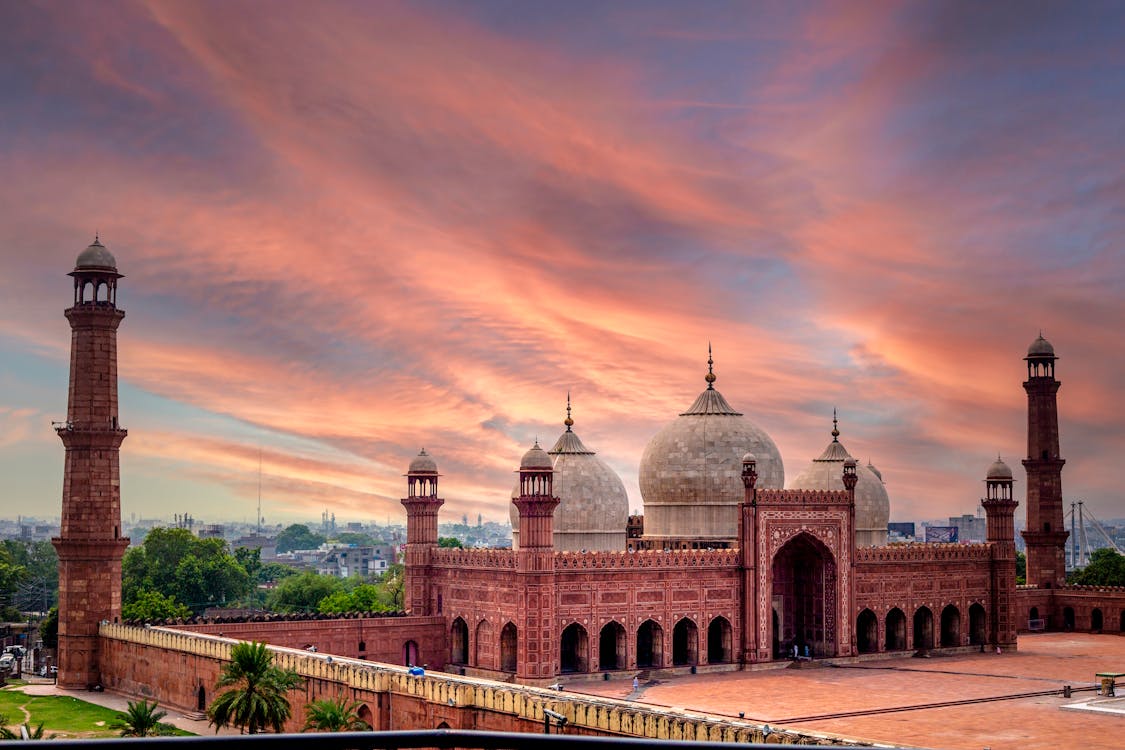The Badshahi Mosque, located in the heart of Lahore, Pakistan, is a symbol of Mughal grandeur and architectural brilliance. Constructed during the reign of the Mughal Emperor Aurangzeb in 1673, this mosque stands as a testament to the rich history and cultural heritage of the Mughal Empire. Known for its stunning architecture, the Badshahi Mosque is one of the largest and most famous mosques in the world.
Historical Background
The Badshahi Mosque was commissioned by Emperor Aurangzeb, the sixth ruler of the Mughal Empire. Aurangzeb was known for his piety and his efforts to promote Islamic culture. The mosque was completed in just two years, a remarkable feat considering its scale and complexity. It was intended to be a statement of imperial power and religious devotion, reflecting the Mughal Empire’s zenith.
Architectural Features
The Badshahi Mosque is renowned for its exquisite architecture. It combines elements of Persian, Central Asian, and Indian design, showcasing the cultural fusion that was characteristic of the Mughal era.
Exterior
The mosque’s exterior is made of red sandstone, which gives it a distinctive and vibrant appearance. The structure is adorned with intricate white marble inlays, adding to its elegance. The mosque’s façade features a grand entrance gate, known as the “Buland Darwaza,” which is an architectural marvel in itself. This gate is flanked by two large minarets, each standing at 176 feet tall, offering a breathtaking view of the surrounding area.
Interior
The interior of the mosque is equally impressive. The main prayer hall is vast, capable of accommodating over 55,000 worshippers. The hall is adorned with beautiful frescoes and intricate marble work, creating a serene and spiritual atmosphere. The ceiling is decorated with delicate floral patterns and Quranic verses, adding to the mosque’s spiritual ambiance.
Courtyard
The mosque’s courtyard is one of the largest in the world, covering an area of approximately 276,000 square feet. The open space allows for communal prayers and gatherings, especially during Islamic festivals such as Eid. The courtyard is surrounded by a colonnade of 78 arches, providing shade and shelter for worshippers.
Cultural and Religious Significance
The Badshahi Mosque holds immense cultural and religious significance for Muslims in Pakistan and around the world. It serves as a major centre for Islamic worship and education. The mosque is particularly crowded during the holy month of Ramadan and on Fridays, when Muslims gather for the Jummah prayer.
Preservation and Restoration
Over the centuries, the Badshahi Mosque has faced the challenges of time and environmental wear. However, extensive restoration efforts have been undertaken to preserve its grandeur. In the 19th century, during the British colonial period, significant repairs were made to the mosque. More recently, the Pakistani government has invested in its restoration, ensuring that this historical gem remains intact for future generations.
Visiting the Badshahi Mosque
For tourists and visitors, the Badshahi Mosque is a must-see attraction in Lahore. Its majestic architecture, coupled with its historical and cultural significance, makes it a captivating site. The mosque is located near other famous landmarks, such as the Lahore Fort and the Minar-e-Pakistan, making it a central point for exploring Lahore’s rich history.
Visitors are required to dress modestly and remove their shoes before entering the mosque premises. It is also important to respect the sanctity of the mosque, especially during prayer times.
Conclusion
The Badshahi Mosque is more than just a place of worship; it is a monument to the artistic and cultural achievements of the Mughal Empire. Its stunning architecture and historical significance make it a treasure of Lahore and a source of pride for Pakistan. Whether you are a history enthusiast, an architecture lover, or someone seeking spiritual solace, the Badshahi Mosque offers an unforgettable experience.
